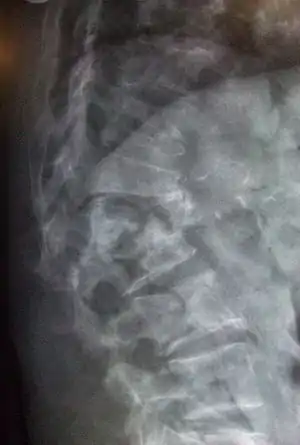Spinal fracture
A spinal fracture, also called a vertebral fracture or a broken back, is a fracture affecting the vertebrae of the spinal column. Most types of spinal fracture confer a significant risk of spinal cord injury. After the immediate trauma, there is a risk of spinal cord injury (or worsening of an already injured spine) if the fracture is unstable, that is, likely to change alignment without internal or external fixation.[1]
| Spinal fracture | |
|---|---|
| Other names | Vertebral fracture, broken back |
 | |
| Lateral spine X-ray showing osteoporotic wedge fractures of L1/2 | |

Types
- Cervical fracture
- Fracture of C1, including Jefferson fracture
- Fracture of C2, including Hangman's fracture
- Flexion teardrop fracture – a fracture of the anteroinferior aspect of a cervical vertebra
- Clay-shoveler fracture – fracture through the spinous process of a vertebra occurring at any of the lower cervical or upper thoracic vertebrae
- Burst fracture – in which a vertebra breaks from a high-energy axial load
- Compression fracture – a collapse of a vertebra, often resulting in the form of a wedge-shape due to larger compression anteriorly
- Chance fracture – compression injury to the anterior portion of a vertebral body with concomitant distraction injury to posterior elements
- Holdsworth fracture – an unstable fracture dislocation of the thoracolumbar junction of the spine
- Distraction is where there is a pulling apart of the vertebrae.[2] Distraction injuries generally cause breaks in osseous and ligamentous supporting structures, and are therefore generally unstable.[3] A distraction injury on the posterior side of a vertebra can lead to a compression fracture on its anterior side.[3]
Cervical fracture
A medical history and physical examination can be sufficient in clearing the cervical spine. Notable clinical prediction rules to determine which patients need medical imaging are Canadian C-spine rule and the National Emergency X-Radiography Utilization Study (NEXUS).[4]
The AO Foundation has developed a descriptive system for cervical fractures, the AOSpine subaxial cervical spine fracture classification system.[5]
The indication to surgically stabilize a cervical fracture can be estimated from the Subaxial Injury Classification (SLIC).[6]
Thoracolumbar fracture
Vertebral fractures of the thoracic vertebrae, lumbar vertebrae or sacrum are usually associated with major trauma and can cause spinal cord injury that results in a neurological deficit.[7]
Thoracolumbar injury classification and severity score
The thoracolumbar injury classification and severity score (TLICS) is a scoring system to determine the need to surgically treat a spinal fracture of thoracic or lumbar vertebrae. The score is the sum of three values, each being the score of the most fitting alternative in three categories:[8]
Injury type
- Compression fracture - 1 point
- Burst fracture - 2 points
- Translational rotational injury - 3 points
- Distraction injury - 4 points
Posterior ligamentous complex
- Intact - 0 points
- Suspected injury or indeterminate - 2 points
- Injured - 3 points
Neurology
- Intact - 0 points
- Spinal nerve root injury - 2 points
- Incomplete injury of cord/conus medullaris - 3 points
- Complete injury of cord/conus medullaris (complete) - 2 points
- Cauda equina syndrome - 3 points
A TLICS score of less than 4 indicates non-operative treatment, a score of 4 indicates that the injury may be treated operatively or non-operatively, while a score of more than 4 means that the injury is usually considered for operative management.[8]
AOSpine Thoracolumbar Injury Classification System
AOSpine Thoracolumbar Injury Classification System (ATLICS)[9] is the most recent classification scheme for thoracolumbar injuries.[10] ATLICS is broadly based on the TLICS system and has sufficient reliability irrespective of the experience of the observer.[10] ATLICS is primarily focused on fracture morphology, and has two additional sections addressing the neurological grading and clinical modifiers:[9]
Fracture morphology
- Type A: Compression injuries (sub-types A0-A4)
- Type B: Distraction injuries (sub-types B1-B3)
- Type C: Translation injuries
Neurological status
Modifiers
- M1: unknown tension band injury status
- M2: comorbidities
References
- "Fracture". MDguidelines by the American Medical Association. Retrieved 2017-10-26.
- Augustine, J.J. (21 November 2011). "Spinal trauma". In Campbell, J.R. (ed.). International Trauma Life Support for Emergency Care Providers. Pearson Education. ISBN 978-0-13-300408-3.CS1 maint: ref=harv (link)
- Clark West, Stefan Roosendaal, Joost Bot and Frank Smithuis. "Spine injury - TLICS Classification". Radiology Assistant. Retrieved 2017-10-26.CS1 maint: multiple names: authors list (link)
- Saragiotto, Bruno T; Maher, Christopher G; Lin, Chung-Wei Christine; Verhagen, Arianne P; Goergen, Stacy; Michaleff, Zoe A (2018). "Canadian C-spine rule and the National Emergency X-Radiography Utilization Study (NEXUS) for detecting clinically important cervical spine injury following blunt trauma". Cochrane Database of Systematic Reviews. doi:10.1002/14651858.CD012989. hdl:10453/128267. ISSN 1465-1858.
- "Classification". AO Foundation. Retrieved 2019-05-08.
- Page 94 and Page 126 in: Douglas L. Brockmeyer, Andrew T. Dailey (2016). Adult and Pediatric Spine Trauma, An Issue of Neurosurgery Clinics of North America. 28. Elsevier Health Sciences. ISBN 9780323482844.
- Mirghasemi, Alireza; Mohamadi, Amin; Ara, Ali Majles; Gabaran, Narges Rahimi; Sadat, Mir Mostafa (November 2009). "Completely displaced S-1/S-2 growth plate fracture in an adolescent: case report and review of literature". Journal of Orthopaedic Trauma. 23 (10): 734–738. doi:10.1097/BOT.0b013e3181a23d8b. ISSN 1531-2291. PMID 19858983.
- Buck Christensen. "Thoracolumbar Injury Classification and Severity (TLICS) Scale". Medscape. Retrieved 2017-10-26. Updated: Dec 09, 2014
- Vaccaro, Alexander R.; Oner, Cumhur; Kepler, Christopher K.; Dvorak, Marcel; Schnake, Klaus; Bellabarba, Carlo; Reinhold, Max; Aarabi, Bizhan; Kandziora, Frank (November 2013). "AOSpine Thoracolumbar Spine Injury Classification System". Spine. 38 (23): 2028–2037. doi:10.1097/brs.0b013e3182a8a381. ISSN 0362-2436. PMID 23970107.
- Abedi, Aidin; Mokkink, Lidwine B; Zadegan, Shayan A; Paholpak, Permsak; Tamai, Koji; Wang, Jeffrey C; Buser, Zorica (October 2018). "Reliability and Validity of the AOSpine Thoracolumbar Injury Classification System: A Systematic Review." Global Spine Journal. 2192568218806847. doi:10.1177/2192568218806847.
External links
| Classification | |
|---|---|
| External resources |